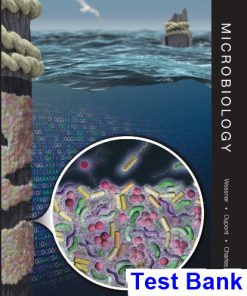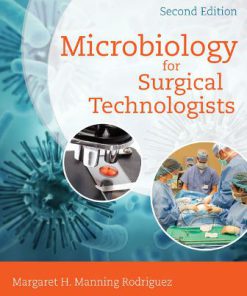Test Bank for Microbiology 2nd by Wessner
$35.00 Original price was: $35.00.$26.50Current price is: $26.50.
Test Bank for Microbiology 2nd by Wessner
Test Bank for Microbiology 2nd by Wessner

Product details:
PART I THE MICROBES
1 The Microbial World 2
1.1 The Microbes 4
Mini-Paper: A Focus on the Research THE THREE DOMAINS OF LIFE 10
Toolbox 1.1 POLYMERASE CHAIN REACTION AMPLIFICATION OF rRNA GENES 12
1.2 Microbial Genetics 15
Perspective 1.1 CREATING LIFE IN THE LABORATORY: THE MILLER–UREY EXPERIMENT 18
1.3 Microbial Physiology and Ecology 23
1.4 Microbes and Disease 26
2 Bacteria 34
2.1 Morphology of Bacterial Cells 36
2.2 The Cytoplasm 38
2.3 The Bacterial Cytoskeleton 41
2.4 The Cell Envelope 43
Perspective 2.1 MARVELOUS MAGNETOSOMES! 44
Toolbox 2.1 THE GRAM STAIN 53
Perspective 2.2 THE PROTECTIVE SHELLS OF ENDOSPORES 54
Mini-Paper: A Focus on the Research NEW MICROSCOPY METHODS REVEAL A PERIPLASM IN GRAM POSITIVE BACTERIAL CELLS 58
2.5 The Bacterial Cell Surface 59
2.6 Diversity of Bacteria 66
3 Eukaryal Microorganisms 72
3.1 The Morphology of Typical Eukaryal Cells 74
Mini-Paper: A Focus on the Research LIPID RAFTS: ORGANIZED CLUSTERING OF LIPIDS WITHIN A MEMBRANE 80
Toolbox 3.1 USING MICROSCOPY TO EXAMINE CELL STRUCTURE 82
Perspective 3.1 HIJACKING THE CYTOSKELETON 86
3.2 Diversity of Eukaryal Microorganisms 86
3.3 Replication of Eukaryal Microorganisms 91
3.4 The Origin of Eukaryal Cells 94
Perspective 3.2 SECONDARY ENDOSYMBIOSIS: THE ORIGINS OF AN ORGANELLE WITH FOUR MEMBRANES 97
3.5 Interactions Between Eukaryal Microorganisms and Animals, Plants, and the Environment 98
4 Archaea 106
4.1 Evolution of Archaea 108
4.2 Archaeal Cell Structure 110
Toolbox 4.1 VACCINE DELIVERY STRATEGIES 115
4.3 Diversity of Archaea 118
Perspective 4.1 EXTREMOPHILES AND BIOTECHNOLOGY 120
Mini-Paper: A Focus on the Research THE ROLE OF ARCHAEA IN OUR DIGESTIVE SYSTEM 124
5 Viruses 130
5.1 A Basic Overview of Viruses 132
5.2 Origins of Viruses 140
Perspective 5.1 RIBOZYMES: EVIDENCE FOR AN RNA-BASED WORLD 141
5.3 Cultivation, Purification, and Quantification of Viruses 143
Toolbox 5.1 CELL CULTURE TECHNIQUES 144
Perspective 5.2 MEASUREMENT OF HIV VIRAL LOAD 147
5.4 Diversity of Viruses 150
Toolbox 5.2 REVERSE TRANSCRIPTASE POLYMERASE CHAIN REACTION (RT-PCR) 154
5.5 Virus-Like Particles 155
5.6 Virology Today 158
Mini-Paper: A Focus on the Research NEW FINDINGS IN THE PACKAGING OF DNA BY THE MODEL BACTERIOPHAGE T4 160
6 Cultivating Microorganisms 164
6.1 Nutritional Requirements of Microorganisms 166
6.2 Factors Affecting Microbial Growth 168
Toolbox 6.1 PHENOTYPE MICROARRAYS FOR EXAMINING MICROBIAL GROWTH 169
6.3 Growing Microorganisms in the Laboratory 173
Perspective 6.1 THE DISCOVERY OF HELICOBACTER PYLORI 178
Toolbox 6.2 FISHING FOR UNCULTIVATED MICROORGANISMS 180
6.4 Measuring Microbial Population Growth 181
Mini-Paper: A Focus on the Research BRINGING TO LIFE THE PREVIOUSLY UNCULTURABLE USING THE SOIL SUBSTRATE MEMBRANE SYSTEM (SSMS) 182
Perspective 6.2 MYCOBACTERIUM LEPRAE, AN EXTRAORDINARILY SLOW-GROWING PATHOGEN 189
Perspective 6.3 THE HUMAN INTESTINE—A CONTINUOUS CULTURE 191
6.5 Eliminating Microbes and Preventing Their Growth 192
PART II MICROBIAL GENETICS
7 DNA Replication and Gene Expression 202
7.1 The Role of DNA 204
7.2 DNA Replication 210
7.3 Transcription 217
Toolbox 7.1 USING A GEL SHIFT ASSAY TO IDENTIFY DNA-BINDING PROTEINS 219
7.4 Translation 222
7.5 The Effects of Mutations 229
Mini-Paper: A Focus on the Research TELOMERES WITH PROMOTER ACTIVITY 232
Perspective 7.1 USING MUTATIONS TO CONTROL VIRAL INFECTIONS 234
8 Viral Replication Strategies 238
8.1 Recognition of Host Cells 240
Perspective 8.1 DNA MICROARRAYS AND THE SARS VIRUS 242
Toolbox 8.1 THE WESTERN BLOT 244
8.2 Viral Entry and Uncoating 246
8.3 Viral Replication 249
Perspective 8.2 PHAGE THERAPY: BIOCONTROL FOR INFECTIONS 256
8.4 Viral Assembly and Egress 258
Mini-Paper: A Focus on the Research THE DISCOVERY OF REVERSE TRANSCRIPTASE 260
9 Bacterial Genetic Analysis andManipulation 264
9.1 Bacteria as Subjects of Genetic Research 266
9.2 Mutations, Mutants, and Strains 269
Toolbox 9.1 ISOLATING NUTRITIONAL MUTANTS 271
9.3 Restriction Enzymes, Vectors, and Cloning 276
9.4 Recombination and DNA Transfer 283
Perspective 9.1 PLASMIDS THAT PRODUCE PATHOGENS 287
Mini-Paper: A Focus on the Research THE DISCOVERY OF TRANSDUCTION 294
10 Microbial Genomics 300
10.1 Genome Sequencing 302
Perspective 10.1 RATE OF DNA SEQUENCING 306
Toolbox 10.1 GENOME DATABASES 310
10.2 Genomic Analysis of Gene Expression 312
10.3 Comparative Genomics 318
Perspective 10.2 THE MINIMAL GENOME 318
Mini-Paper: A Focus on the Research GENOME SEQUENCE OF A KILLER BUG 320
10.4 Metagenomics and Related Analyses 323
11 Regulation of Gene Expression 328
11.1 Differential Gene Expression 330
11.2 The Operon 332
11.3 Global Gene Regulation 337
Mini-Paper: A Focus on the Research TUNING PROMOTERS FOR USE IN SYNTHETIC BIOLOGY 338
Perspective 11.1 THE USE OF LACTOSE ANALOGS IN GENE EXPRESSION STUDIES 342
11.4 Post-initiation Control of Gene Expression 345
Toolbox 11.1 USING RNA MOLECULES TO DECREASE GENE EXPRESSION 347
11.5 Quorum Sensing 348
11.6 Two-Component Regulatory Systems 351
11.7 Chemotaxis 354
12 Microbial Biotechnology 360
12.1 Microbes for Biotechnology 362
Perspective 12.1 BIOPROSPECTING: WHO OWNS THE MICROBES? 364
12.2 Molecular Genetic Modification 366
Toolbox 12.1 SITE-DIRECTED MUTAGENESIS 368
Toolbox 12.2 FUSION PROTEIN PURIFICATION 374
Mini-Paper: A Focus on the Research MAKING A SYNTHETIC GENOME 376
Perspective 12.2 THE INTERNATIONAL GENETICALLY ENGINEERED MACHINE (IGEM) COMPETITION, STANDARD BIOLOGICAL PARTS, AND SYNTHETIC BIOLOGY 378
12.3 Red Biotechnology 379
12.4 White Biotechnology 381
Perspective 12.3 BIOFUELS: BIODIESEL AND ALGAE 384
12.5 Green Biotechnology 390
Toolbox 12.3 PLANT TRANSFORMATION USING BACTERIA 392
PART III MICROBIAL PHYSIOLOGY AND ECOLOGY
13 Metabolism 400
13.1 Energy, Enzymes, and ATP 402
Perspective 13.1 WHO NEEDS VITAMINS? 405
13.2 Central Processes in ATP Synthesis 406
13.3 Carbon Utilization in Microorganisms 412
13.4 Respiration and the Electron Transport System 421
Perspective 13.2 ELECTRICIGENIC BACTERIA AND MICROBIAL FUEL CELLS 425
13.5 Metabolism of Non-glucose Carbon Sources 429
Toolbox 13.1 METABOLISM AND RAPID BACTERIAL IDENTIFICATION SYSTEMS 431
13.6 Phototrophy and Photosynthesis 433
13.7 Nitrogen and Sulfur Metabolism 442
Mini-Paper: A Focus on the Research GENOME SEQUENCE OF A DEEP SEA SYMBIONT 443
13.8 Biosynthesis of Cellular Components 448
14 Biogeochemical Cycles 456
14.1 Nutrient Cycling 459
Toolbox 14.1 USING MICROARRAYS TO EXAMINE MICROBIAL COMMUNITIES: The Geochip 461
14.2 Cycling Driven by Carbon Metabolism 462
Perspective 14.1 CO2 AS A GREENHOUSE GAS AND ITS INFLUENCE ON CLIMATE CHANGE 464
14.3 Cycling Driven by Nitrogen Metabolism 471
Mini-Paper: A Focus on the Research THE FIRST ISOLATION AND CULTIVATION OF A MARINE ARCHAEON 476
14.4 Other Cycles and their Connections 476
Perspective 14.2 LIFE IN A WORLD WITHOUT MICROBES 478
Perspective 14.3 THE MICROBIOLOGY OF ENVIRONMENTALLY TOXIC ACID MINE DRAINAGE 479
Toolbox 14.2 BIOGEOCHEMISTRY IN A BOTTLE: THE WINOGRADSKY COLUMN 481
15 Microbial Ecosystems 486
15.1 Microbes in the Environment 488
15.2 Microbial Community Analysis 493
Toolbox 15.1 FLOW CYTOMETRY 498
Mini-Paper: A Focus on the Research INSIGHTS INTO THE PHYLOGENY AND CODING POTENTIAL OF MICROBIAL DARK MATTER 500
Perspective 15.1 NAMING THE UNCULTURED AND UNCHARACTERIZED 502
15.3 Aquatic Ecosystems 502
Perspective 15.2 DEAD ZONES 503
15.4 Terrestrial Ecosystems 509
15.5 Deep Subsurface and Geothermal Ecosystems 515
16 The Microbiology of Foodand Water 524
16.1 Food Spoilage 526
16.2 Food Preservation 530
16.3 Food Fermentation 535
16.4 Foodborne and Waterborne Illness 542
16.5 Microbiological Aspects of Water Quality 545
Perspective 16.1 IMPLICATIONS OF SLUDGE BULKING 550
Toolbox 16.1 MEASURING BIOCHEMICAL OXYGEN DEMAND (BOD) 551
Mini-Paper: A Focus on the Research ENHANCED BIOLOGICAL REMOVAL OF PHOSPHORUS 553
Toolbox 16.2 MOST PROBABLE NUMBER (MPN) METHOD 556
17 Microbial Symbionts 562
17.1 Types of Microbe-Host Interactions 564
17.2 Symbionts of Plants 566
17.3 Symbionts of Humans 571
Toolbox 17.1 GERM-FREE AND GNOTOBIOTIC ANIMALS 575
Perspective 17.1 FOOD PROBIOTICS—DO THEY WORK? 577
Mini-Paper: A Focus on the Research FECAL BACTERIOTHERAPY: “REPOOPULATION” OF THE GUT 580
17.4 Symbionts of Herbivores 582
Perspective 17.2 COWS CONTRIBUTE TO CLIMATE CHANGE 588
17.5 Symbionts of Invertebrates 588
Perspective 17.3 MIDICHLORIANS—NOT JUST FOR JEDI 592
Perspective 17.4 DEATH OF CORAL REEFS 595
PART IV MICROBES AND DISEASE
18 Introduction to InfectiousDiseases 600
18.1 Pathogenic Microbes 603
Toolbox 18.1 MEASURING THE VIRULENCE OF PATHOGENS 605
18.2 Microbial Virulence Strategies 607
Perspective 18.1 GENOME EDITING: A POWERFUL AND CONTROVERSIAL NEW TECHNIQUE 613
18.3 The Transmission of Infectious Diseases 614
Mini-Paper: A Focus on the Research EPIDEMIOLOGY OF AN INFECTIOUS DISEASE 622
18.4 Proving Cause and Effect in Microbial Infections 624
Perspective 18.2 THE ARMADILLO—AN IDEAL ANIMAL MODEL? 628
18.5 The Evolution of Pathogens 629
19 Innate Host Defenses Against Microbial Invasion 638
19.1 Immunity 640
19.2 Barriers to Infection 641
Perspective 19.1 MESSY MUCUS 644
19.3 The Inflammatory Response 645
19.4 The Molecules of the Innate System 646
Mini-Paper: A Focus on the Research MAMMALIAN CELLS CAN RECOGNIZE BACTERIAL DNA 650
Toolbox 19.1 THE COMPLEMENT FIXATION TEST 654
19.5 The Cells of Innate Immunity 657
19.6 Invertebrate Defenses 665
Toolbox 19.2 THE LIMULUS AMOEBOCYTE ASSAY FOR LPS 667
People also search:
apurba sastry microbiology 2nd edition
|
bsc microbiology 2nd sem question papers
b.sc microbiology 2nd year syllabu
prescott’s principles of microbiology 2nd edition
msc microbiology 2nd sem syllabus
essential microbiology 2nd edition pdf
bsc microbiology 2nd sem syllabus
|












